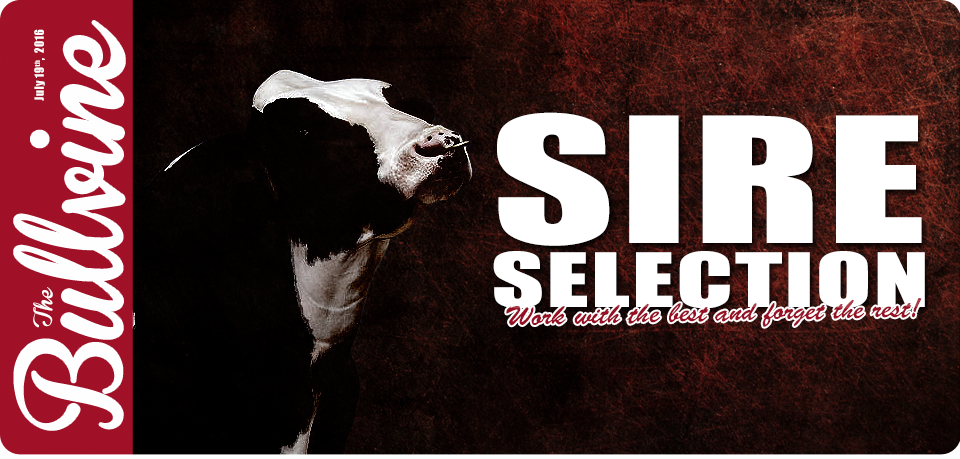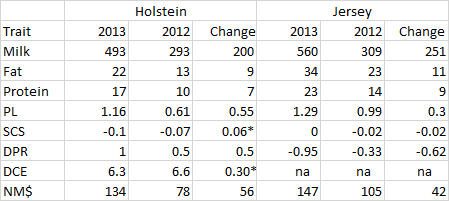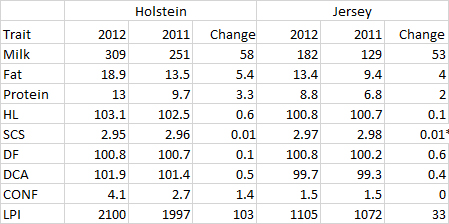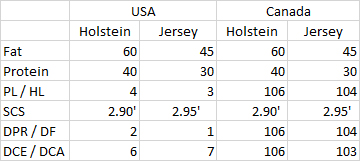There is considerable debate among dairy cattle breeders, whether breeding is an art form or science? With most telling you it takes a combination of both to achieve sustained success. The question becomes how you can improve your current breeding program to go from good to great? The answer lies in your sire selection intensity. When you work with only the best sires you will achieve the greatest success.
Dairy cattle breeders use science and numbers every day when they go about selecting a bull to use or when they cull a female from their breeding program. The rigor and intensity of these two acts has a great bearing on the genetic progress that a herd can make. When it comes to the genetics added to or removed from a herd, the question every breeder must continually ask is – “Am I being demanding enough?”.
You have to Apply the Science or Lose Genetic Progress
In measuring genetic progress, four factors are considered: a) the superiority (or inferiority) of the animal selected (or culled); b) accuracy, on a genetic basis, of the information used; c) genetic variation for the trait under consideration, and d) the generation interval from parents to progeny. The sum of a, b and c is divided by d to get an annual genetic gain.
The superiority of the animals used as parents is a vital factor over which a breeder has control in genetic improvement in a trait. Only using the very best sires and dams when adding females to the breeding herd will move a herd forward rapidly for the traits under consideration. This is referred to as the intensity of selection. (Read more: The Genomic Advancement Race – The Battle for Genetic Supremacy Sire vs. Dam – Which has a Greater Impact on Your Herd’s Genetic Improvement?, and Impact of Genomics on Genetic Selection and Gain)
Why You Should Care about Genetic Improvement
In the future, dairy cattle breeders will be more interested in their overall herd improvement rather than in producing one or two breed list toppers or show winners, while being satisfied with their herd being just average. The focus will be on total farm profit. The dairy cattle breeding industry is seeing this change already where breeders are following programs that use sexed semen, use only top indexing sires, use only implanted embryos from elite females, use low indexing females as recipients or mothers of beef calves and select for the future generations based on economically important traits.
A.I.’s are doing the same. Some A.I.’s are breeding to get breed topping males, and others are breeding to produce top males and top females. These breeding companies want their products to provide their customers with the opportunity to maximize profit in the era of narrowing margins, automation, guaranteed product quality and feeding a hungry world.
Where the maximum rate of genetic improvement was once thought to be 1% per year, it can now be 1.5% for some traits in both Holstein and Jersey populations.
Recent rates of genetic improvement are as follows:
Table 1 Genetic Trends in USA – Average Breeding Values (Cows)
Notes: 1. Data Source is CDCB
2. Years compared are the birth years for females
3. * change is postive due to method of trait expression
Table 2 Genetic Trends in Canada – Average Indexes (Cows)
Notes: 1. Data Source is CDN
2. Years compared are the birth years for females
3. * change is positive due to the method of trait expression
Breeders are effectively using genetic information to make significant improvement and, therefore, that rate of improvement is speeding up. From studying sire usage in recent years, we know that the rates will increase even more.
Is Genetic Improvement REAL?
For those breeders who question whether genetic improvement is being made, here are five places it can be seen:
- type in the show ring
- a lower percent of low producing first lactation cows in herds
- improved type animals in milk production herds
- elite brood cows leaving not two or three but many high daughters and sons, and
- many more top indexing unproven sires are leaving top daughters and sons.
Focus, Focus, Focus on Traits Needing Improvement
In 2021 dairy farming will be considerably advanced. The cows in the herds then will face different conditions.
- Increasing use of automated systems where each worker will be covering twice as many cows.
- Improved animal health and disease resistance to ship milk
- Animal fertility will be improved as seen in calving ease/days to first heats/conception rates
- Cows, on average, will complete four lactations (currently it is less than three)
- New traits will be available for breeders to use (Read more: Can you breed a healthier cow? and The Complete Guide to Understanding Zoetis’ New Wellness Traits – CLARIFIDE® Plus)
Given this scenario, The Bullvine recommends that breeders consider placing their focus on three or four of the following traits.
- Fat yield
- Protein yield
- Productive Life / Herd Life
- Daughter Pregnancy Rate / Daughter Fertility
- SCS and animal disease resistance
- Daughter Calving Ease / Daughter Calving Ability
These are key traits in order to drive up revenue or decrease expenses and extend the average length of herd life on a per cow basis.
Readers will note that The Bullvine has not included total merit indexes (TPI, JPI, LPI, NM$, CM$ or Pro$) in its trait list. The reason for not including such indexes is that they are a sum of all traits included in them, and thereby there can be animals with high total merit indexes, but that can be deficient for traits recommended in the previous list.
When Good is NOT Good Enough
Sires used today do not have milking daughters until three years from now. Their indexes must be significant pluses today just to be average by then. For example, in North America Holstein and Jersey sires must be +30 lbs fat today to be average in 2019. For PL it would be +1.75 for a US Holstein sire and for CONF it would be over + 4 for a Canadian Holstein Sire. In general, a sire needs to be 10% – 20% above the current average for a trait in order to be just average when his daughters are in their first lactation.
But average today in three year’s time will not be good enough!
The Bullvine recommends that sires used today have at least the following indexes:
Table 3 Recommended Minimum Indexes When Selecting Proven Sires
Pick Your Sires
The following tables contain daughter proven sires that are superior for the list of Bullvine recommended traits.
Table 4 Proven Sires That Are Superior for Bullvine Recommended Traits
| PL / HL | Fat | Protein | SCS | DPR / DF | DCE/DCA | NM$/Pro$ | ||
|---|---|---|---|---|---|---|---|---|
| USA Holsteins | ||||||||
| Cabriolet | 1HO10396 | 9.1 | 93 | 46 | 2.99 | 0.6 | 2.9 | 852 |
| Monocerotis | 7HO11839 | 8.4 | 56 | 56 | 2.88 | 1.8 | 4.5 | 777 |
| Mystic | 7HO11395 | 7.9 | 61 | 39 | 2.81 | 3.8 | 5.2 | 712 |
| Donatello | 7HO11525 | 6.6 | 74 | 47 | 2.84 | 0.9 | 4.6 | 740 |
| Rainier | 1HO10559 | 5.6 | 86 | 47 | 2.92 | 1.5 | 6.3 | 703 |
| USA Jerseys | ||||||||
| Machete | 1JE00792 | 6.2 | 51 | 43 | 2.87 | 0.7 | na | 563 |
| Daybreak | 29JE03768 | 5.2 | 51 | 45 | 2.98 | 0.3 | na | 534 |
| Magnum | 203JE00927 | 3 | 82 | 42 | 2.96 | 1.6 | na | 544 |
| Canadian Holsteins | ||||||||
| Pinkman | 200HO06320 | 114 | 66 | 44 | 2.80' | 109 | 105 | 2190 |
| Altavittek | 11HO10909 | 112 | 46 | 50 | 2.35' | 107 | 113 | 2010 |
| Altaembassy | 11HO11143 | 111 | 76 | 39 | 2.52' | 104 | 108 | 2242 |
| Day | 1HO10458 | 109 | 57 | 61 | 2.69' | 106 | 104 | 2206 |
| Brewmaster | 250HO01009 | 108 | 136 | 58 | 2.71' | 106 | 107 | 2333 |
| Canadian Jerseys | ||||||||
| Premier | 29JE03756 | 104 | 61 | 35 | 2.86' | 106 | 110 | 1611 |
| Irwin | 7JE01163 | 103 | 39 | 33 | 2.90' | 96 | 100 | 1309 |
| Dignitary | 7JE01150 | 102 | 81 | 55 | 2.68' | 103 | 102 | 1571 |
Breeders should set up their own list of focus traits. On-farm profit focused breeders will focus on traits where their current herd is not genetically high. While show breeders everywhere may wish to select for Holstein cows with less stature but correct conformation as 60 inches (150 cm) may be the ideal stature in five years’ time. After viewing, on-line, the animals at the recent EU Championship Show, it appears that EU breeders have already adopted having less extremely tall Holstein cows.
Since the genomic sire lists change almost monthly, it serves only a limited purpose to provide a list of top genomic sires. The Bullvine recommends that the values in Table 3 be increased by 25% for genomic sires to help balance out for the lower accuracy of the indexes. Of course the industry standard recommendation applies, do not use only one genomic sire in a herd. It is much better to buy ten doses from each of five genomic sires than fifty doses from only one genomic sire. (Read more: 4 Steps to Faster Genetic Improvement)
The Bullvine Bottom Line
Using AVERAGE sires is not good enough especially when there exists the opportunity to have many more top animals in your herd by using sires that EXCEL. This also applies for the female side of breeding. Increasing the genetic merit levels required for animals selected as parents of the next generation will always pay big dividends. By taking these actions and increasing your selection intensity, you will take your current breeding programs from good to great and see enduring success.
Get original “Bullvine” content sent straight to your email inbox for free.





















Leave a Reply
You must be logged in to post a comment.